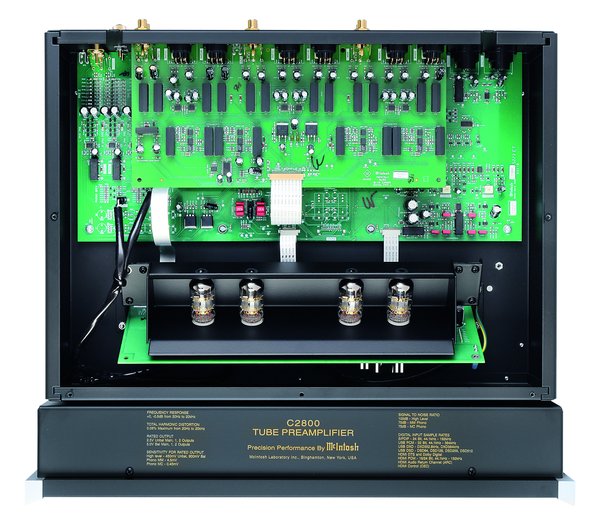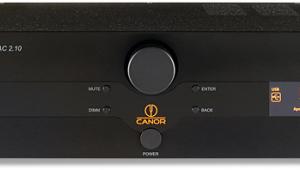McIntosh C2800

 Surely the most compelling of two same-priced preamplifiers in the McIntosh range, both equipped with its custom DA2 digital module. Why? Only the C2800 has tubes...
Surely the most compelling of two same-priced preamplifiers in the McIntosh range, both equipped with its custom DA2 digital module. Why? Only the C2800 has tubes...
Think valve amplifiers, and the chances are the image brought to mind is that of a minimalist device, with little apart from a source selector, volume control and output stage. And when we're talking about valve preamplifiers, things might be even simpler. Well, clearly that particular memo went straight into the junk folder at McIntosh Labs' HQ in upstate New York, as the new £11,995 C2800 valve preamp is anything but minimalist.
This imposing product has no fewer than 16 inputs, seven of them digital and two of the other nine ready for a brace of turntables; more home automation connectivity than you could shake an Ethernet cable at; and even a dedicated app - for iOS and Android - for setup and control [see boxout, p67]. Then again, valves not your thing? Check out the very similar C55 that was launched alongside the C2800 - same range of inputs, connections and configurability, and at the same price, but entirely solid-state. Quite literally, you pays yer money...
 A pair of 12AX7A (ECC83) triodes per
channel and one 12AT7 (ECC81) form the core of
the line preamplifier while the USB/HDMI/MCT
and S/PDIF-equipped DA2 module is housed in a
separately screened enclosure, below
A pair of 12AX7A (ECC83) triodes per
channel and one 12AT7 (ECC81) form the core of
the line preamplifier while the USB/HDMI/MCT
and S/PDIF-equipped DA2 module is housed in a
separately screened enclosure, below
Brand Designs
The look of the C2800 is recognisably 'McIntosh', from the blue illuminated VU meters to the green backlit logo and the very retro two-line blue on black dot-matrix display. Just two main controls are used - one for input, the other for volume, though both have additional functions when you push rather than twist. Sensibly sized buttons cover power, output, tone control on/bypass, and muting. So yes, this is more involved than the valve preamp stereotype, but still nothing here should confuse.
The C2800 has both Ethernet and USB-A ports, but neither has any audio capability. The latter is for service access, the former for control connection via a home network and the new McIntosh Connect app. Much of what the app provides can be accessed by drilling down through the unit's menus using the front panel controls, but the app is a much clearer way of doing things, and without all the pushing, holding, twisting and drilling. There's also a conventional system remote handset [see p69].
The digital section here is served by Mcintosh'S DA2 DAC module, which offers file handling up to 384Khz/24-bit and DSD512, depending on the input, of which there's a wide range. A USB-B port serves for connection to a computer (which also allows Roon integration); HDMI ARC is provided for video sources, able to downconvert from Dolby and DTS surround to stereo and with adjustable lip-sync delay; McIntosh's proprietary multipin MCT connection permits secure data transfer from the company's MCT500 SACD transport; and there are also two optical and two coaxial inputs on the preamp's busy back panel.
 Ethernet is for control only (USB-A as a service port) with digital audio on
USB-B (DSD512/384kHz), 2x optical/coax, HDMI ARC and an MCT socket (for DSD).
Analogue ins are on RCAs (4x line, MM/MC) and 3x XLRs. A processor loop joins 3x
outputs on RCA/XLRs. Multiple trigger and data ports serve automated systems
Ethernet is for control only (USB-A as a service port) with digital audio on
USB-B (DSD512/384kHz), 2x optical/coax, HDMI ARC and an MCT socket (for DSD).
Analogue ins are on RCAs (4x line, MM/MC) and 3x XLRs. A processor loop joins 3x
outputs on RCA/XLRs. Multiple trigger and data ports serve automated systems
Get Connected
Analogue inputs? Yup, the C2800 has lots of them. As well as the phono inputs, configurable for MM and MC with adjustable gain and loading, there are four line-ins on RCAs, and three sets of balanced XLRs. These can be remotely switched, and it's possible to memorise input trims and tone control settings for each and change their names.
Outputs are available on XLRs and phonos, with high-pass and low-pass filter options, plus adjustment of their relative level to suit the sensitivity of different power amps in a bi-amp system. There's also a set of RCAs for one or more subwoofers, configurable as stereo or two mono outputs, plus an in/out processor loop for those wanting to integrate the C2800 into an AV system.
Completing the feature roster - well sort of, as there's lots more buried in all those menus - is a headphone output powered by McIntosh's 'High Drive Headphone Amplifier with Headphone Crossfeed Director', allowing 'bleed' between the channels intended to give a more speaker-like listening experience. Oh, and there's that bank of 12V trigger, infrared sensor and remote control connections - no fewer than 14 of them, which should be more than enough for even the most fanatical custom installer.
Clearly, this isn't your run-of-the-mill hairshirt valve preamp, complete with a requirement to know the dark arts and the Way of the Tube to hear it at its best. Rather, the C2800 feels like the valve preamp made user friendly as well as flexible enough to accommodate every stripe of enthusiast. Neither is it any bigger than many a solid-state preamp, at just 44.4cm wide, a shade deeper front to back, and less than 20cm tall, and while it feels solid and beautifully made, it's not excessively heavy at around 12.5kg.
Warm Embrace
Listening to the C2800 in action, just when you think McIntosh has gone all-out to prove that everything you thought you knew about valve amps is wrong, it becomes clear that the complement of valves, showcased via a glass panel in the top of the unit, is doing its stuff. Even when used with a power amp known for its speed and drive - such as my original 1990s vintage Naim NAP 250 [see HFN Jan '14] - it's hard not to overlook the sweetness and liquid flow this preamp brings to the music.
Playing the Maxwell Quartet's 2021 release of Haydn's Op. 74 String Quartets [Linn 96kHz/24-bit download, CKD641], the sound was rather warmer than I am used to with the partnering Naim NAC 52 of similar vintage in harness, but compensation arrives in the striking ease of listening the C2800 delivers while maintaining insight into both performance and recording.
Inspired by the Scottish folk songs also included on this Linn release, I somehow segued into the massive Steeleye Span Good Times Of Old England compilation [Chrysalis Catalogue CRB1491], and the dramatically vitriolic 'Cam Ye O'er Frae France', with its deep bass and slashes of guitar. This appears in both the studio version and as several live recordings on this 12-disc set, and via the C2800, these deeper parts of the Steeleye catalogue were revealed with attack and emotion, just as the musicianship of the lineup was clear on the less familiar tracks, such as the haunting 'Fighting For Strangers'.
Viva La Valves
Having enjoyed Coldplay's Glastonbury 2024 set via the C2800's HDMI input fed from my Samsung TV, I loaded up some of the band's big numbers over that weekend. The preamp's rich but open presentation was just the thing for the title track from the 'Prospekt's March' edition of Viva La Vida [Parlophone 264 7112], with its multiple layers, huge dynamics and punchy rhythms accented by a tight string section. All that was missing was the light show and the confetti cannons as the C2800 dispelled any erroneous thoughts of slow and smooth valve amps. The sound is definitely warm and rich, but there's no shortage of drive and resolution.
With more intimate material, the C2800 gets its teeth into not just the tonality but the space around a performance. This was clear with Rebeca Omordia's recording of Salim Dada's 'Miniatures Algériennes' [African Pianism, Vol. 2; SOMM CD0688, 96kHz/24-bit], where the dancing rhythms were delivered with thrilling speed and dynamics, and a sense of the music 'breathing' in the studio acoustic.
On, then, to a familiar test track but here in a new form - Yes's 'Roundabout', in the Steven Wilson remix from 2024's Super Deluxe edition of Fragile [Atlantic R2 726068]. With the sound further opened up, the C2800 gave voice to a huge, complex soundscape, but with superb focus on Steve Howe's acoustic guitar, Mr Wakeman's keyboard noodling and the grumbling, rumbling bass of Chris Squire trading blows with Bill Bruford's powerhouse drumming. It's a stunning mix, and the C2800 played its part in delivering all the detail, heft and drive to my Naim power amp, allowing the speakers to kick hard while remaining totally in control.
The Right Stuff
The more I used the C2800, the more I came to appreciate its blend of clarity and focus. Some might prefer a preamp with a simpler specification, or perhaps the multiband equaliser that's writ large across the solid-state C55, but I have to admit I didn't use its subtle tone controls beyond a brief period of experimentation to explore their effect. Frankly, I was more than happy with the basic rightness of the C2800's sound, and the way so much functionality has been packed in seemingly with no deleterious effect on the performance.
'Real-world' isn't a description many would apply to a product costing the thick end of £12,000, and probably requiring a similar amount to be invested in power amplification. However, I think what McIntosh has got here is an exceptional valve preamp with excellent performance, all the inputs almost anyone could ever want, and no sign of valve quirkiness to frighten the horses.
Hi-Fi News Verdict
The C2800 is characterful, and while its underlying warmth may not please the 'red in tooth and claw' merchants who'd like a more upfront sound, there's still so much to like here, from the connectivity - though who'll use all those control sockets? - to a sound that's rich and bold while also fast and dynamic. Think valves only do lush bass and stripped-back jazz recordings? It's time to reconsider.

























































